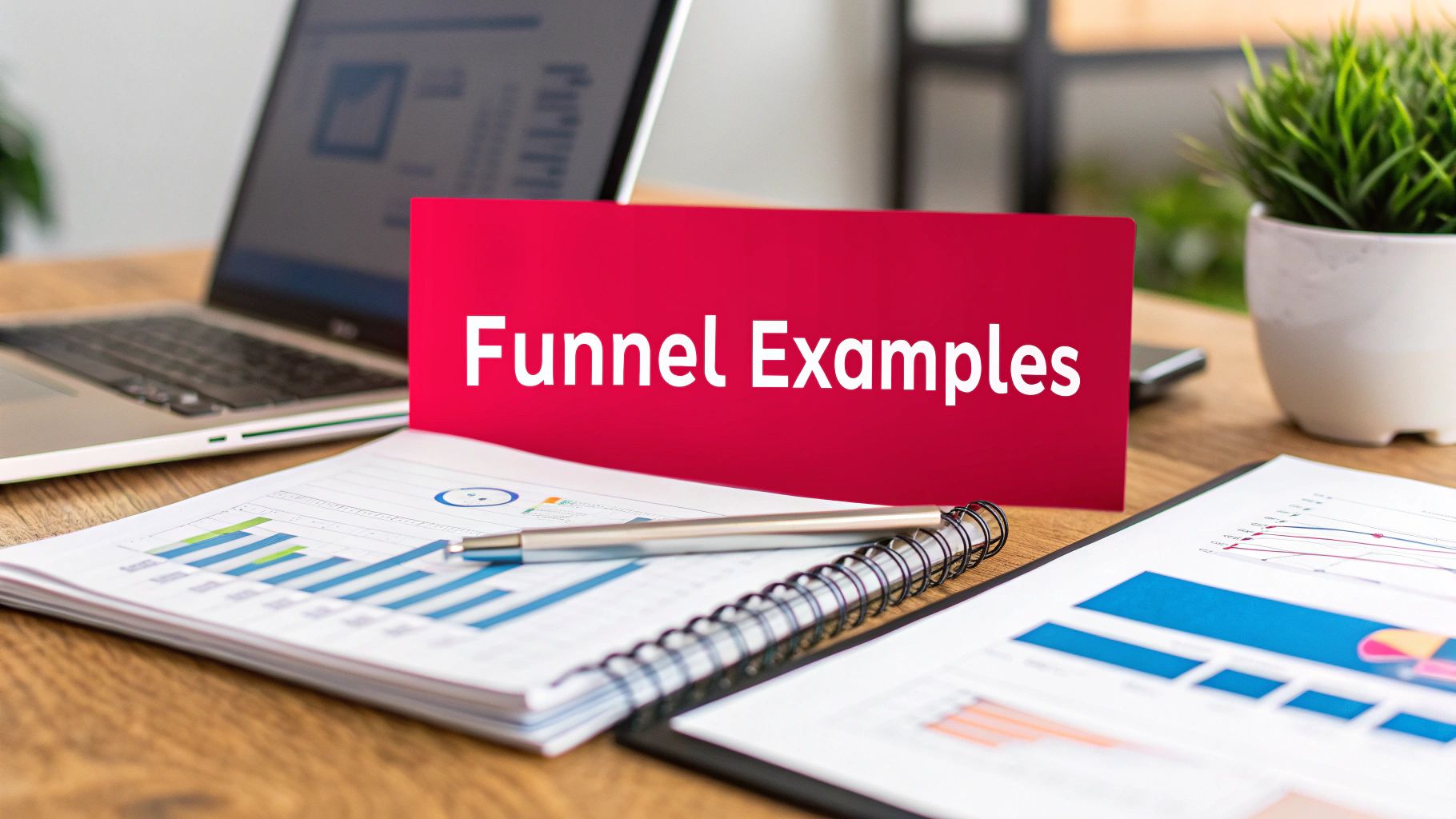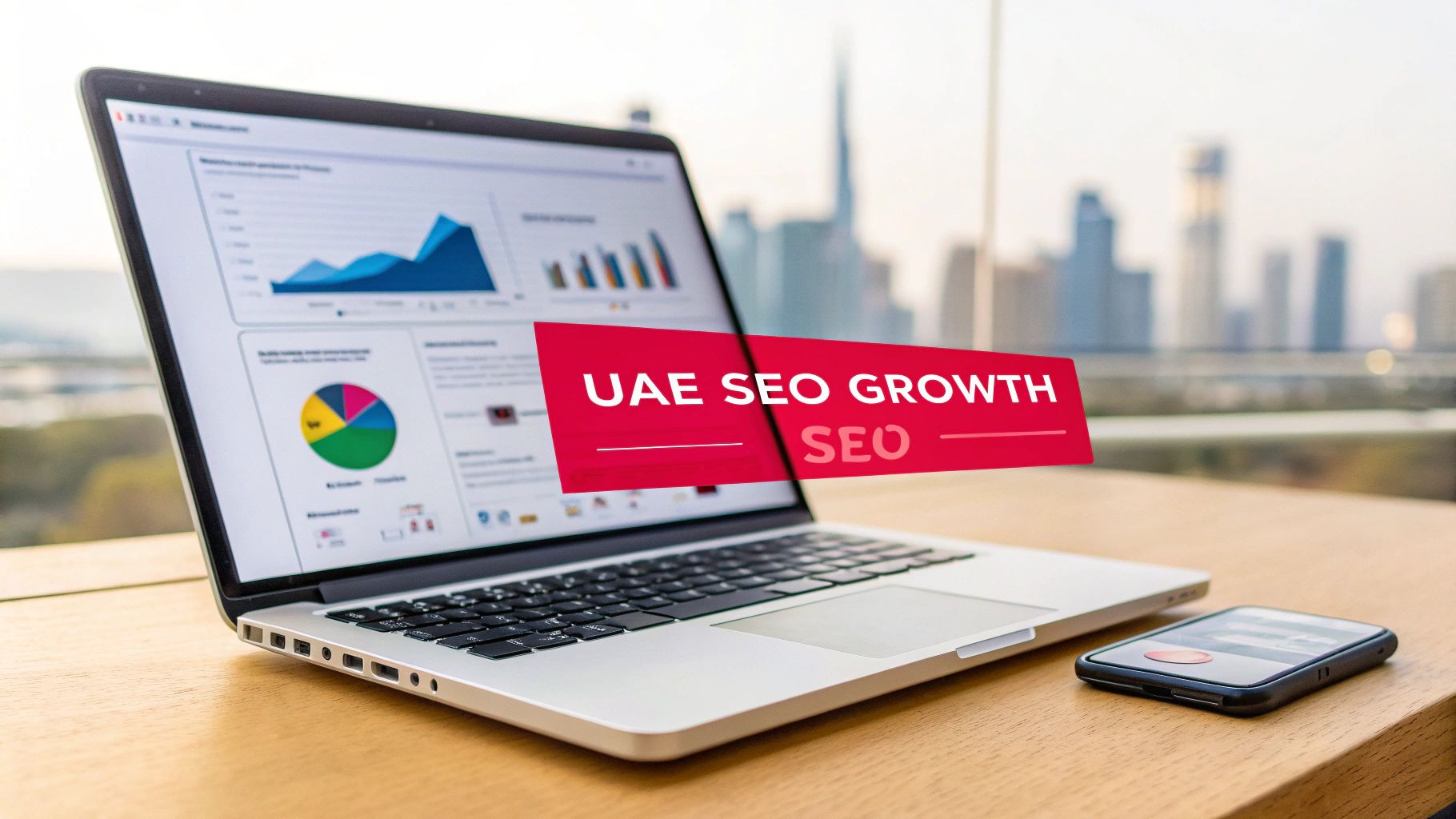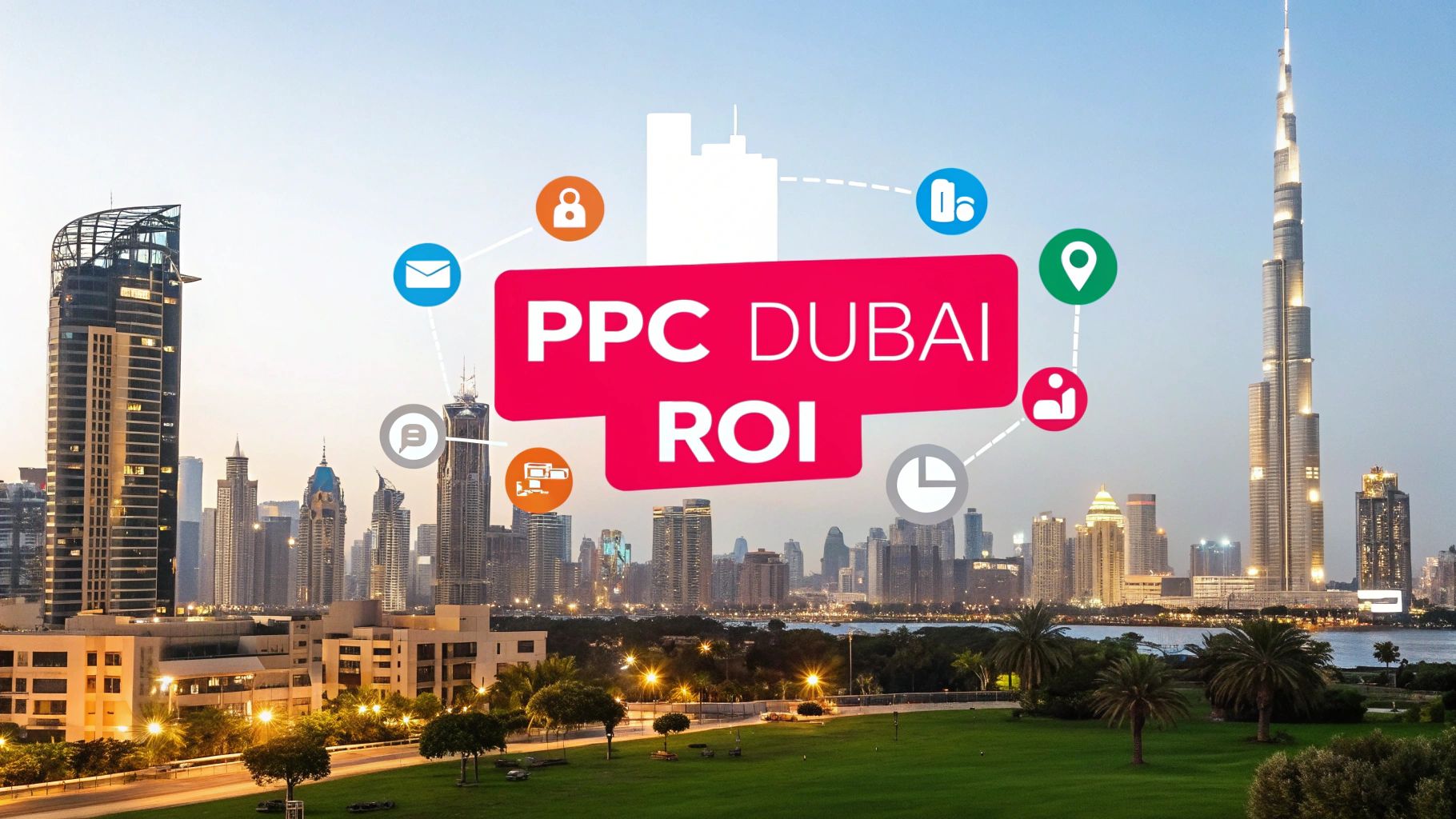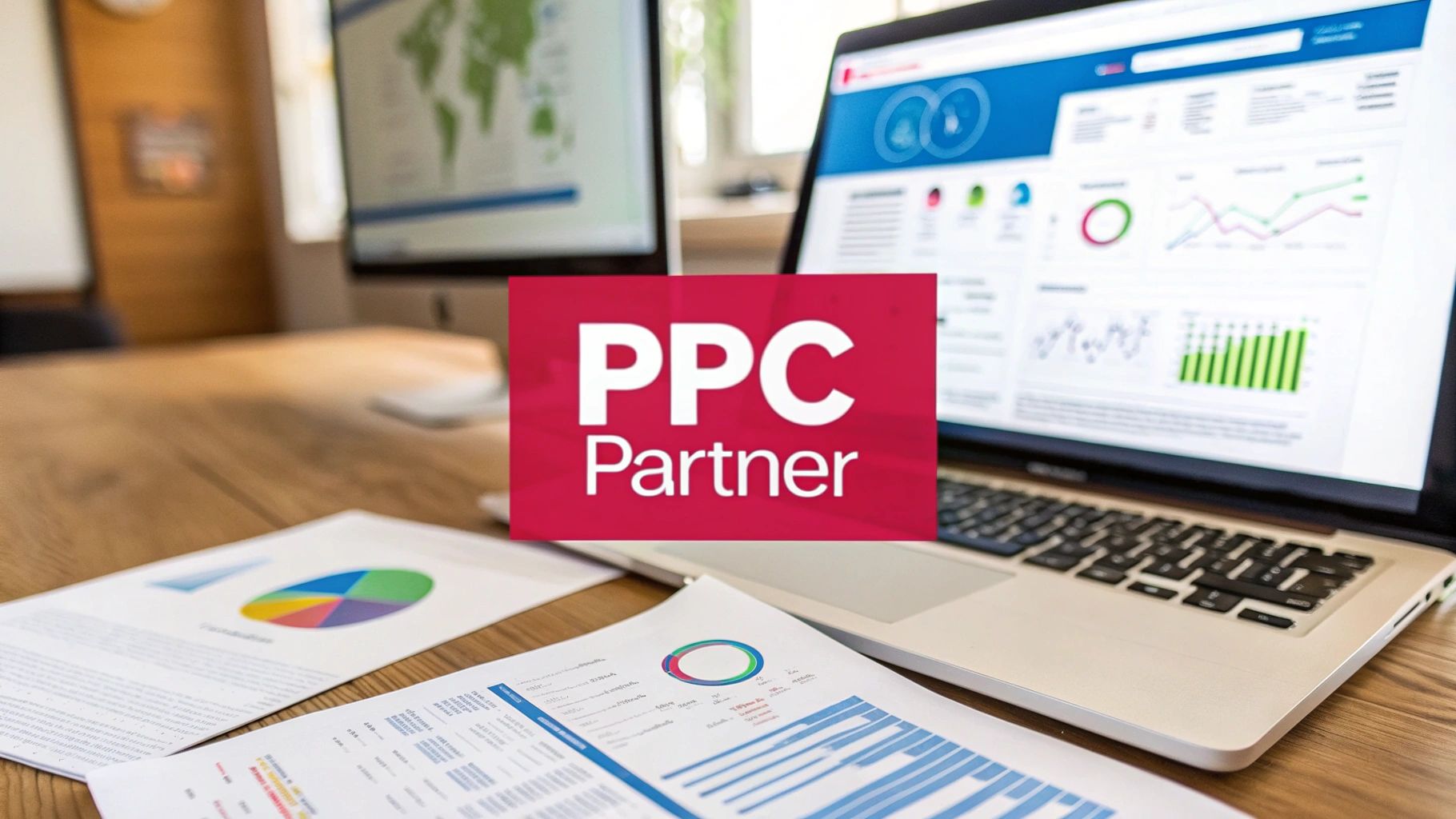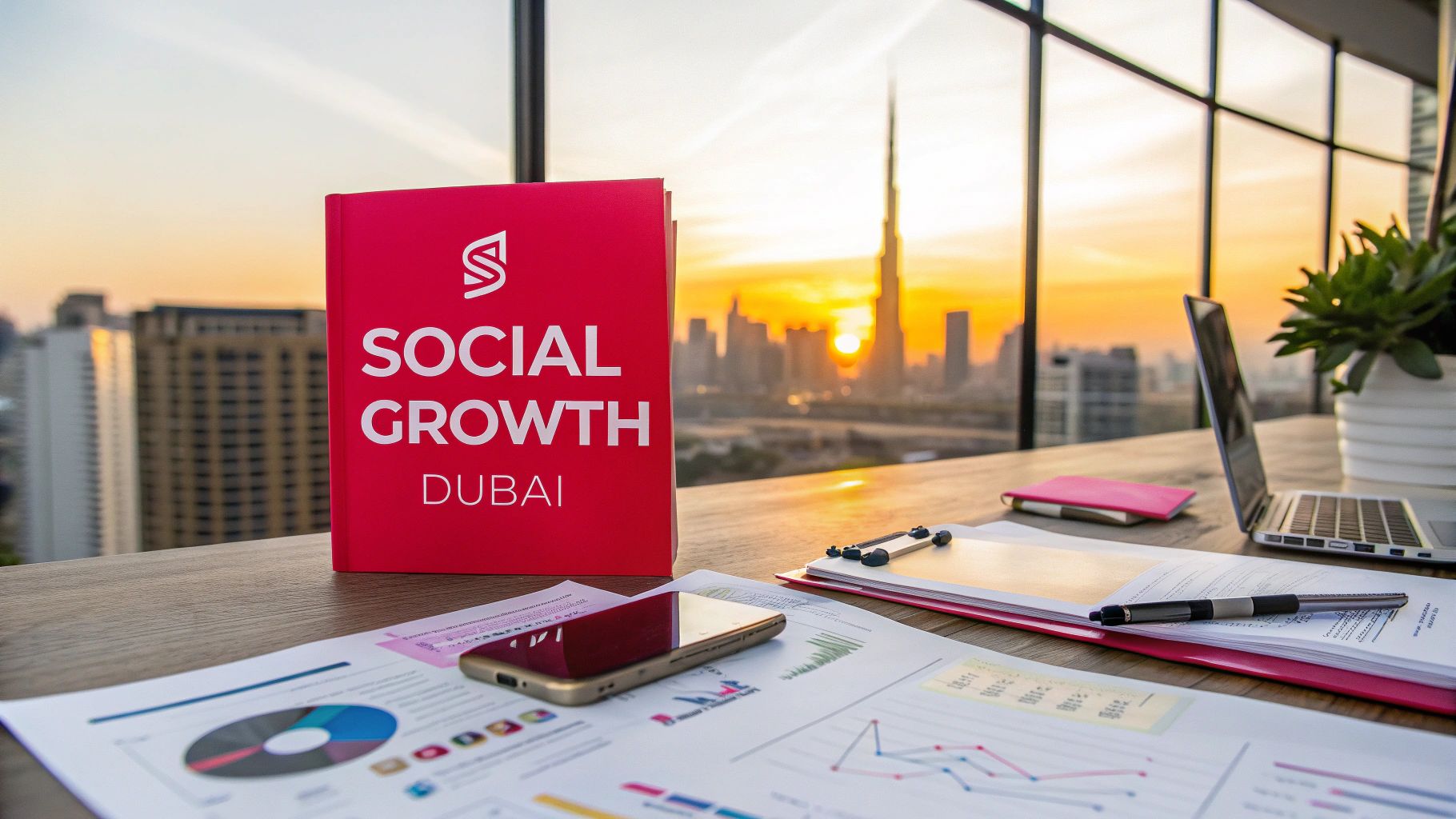Understanding the customer journey from first glance to final purchase is fundamental to business growth. Today's most successful brands don't just wait for customers to find them; they build a sophisticated pathway that guides prospects from initial awareness to loyal advocacy. This process, known as the marketing funnel, is the engine behind sustainable revenue and brand loyalty. This guide moves beyond abstract theories to dissect the architecture of high-performance campaigns. We will break down eight distinct marketing funnel examples, revealing the exact strategies, tactics, and psychological triggers they use to achieve remarkable results.
Whether you're a startup founder in Dubai, an e-commerce retailer looking to boost sales, or a B2B company in Abu Dhabi needing to generate quality leads, you'll find actionable blueprints here. The models we will explore are designed to be adapted to your unique business needs and market. This article will provide the practical insights required to build a system that consistently turns browsers into buyers.
We will explore the classic AIDA model, a content-driven approach, powerful webinar funnels, social media strategies, and more. Each example is a case study in effective customer acquisition and nurturing. To truly maximise the effectiveness of your funnels, it's crucial to continuously implement strategies for conversion rate optimization, turning small improvements into significant gains. Prepare to explore real-world models that generate leads, foster relationships, and drive measurable growth for your organisation.
1. The Foundational Blueprint: AIDA Marketing Funnel Example
The AIDA model, which stands for Attention, Interest, Desire, and Action, is the bedrock upon which many complex marketing funnels are built. Developed in the late 19th century, its logical, psychology-driven sequence for guiding potential customers remains profoundly relevant. As one of the most essential marketing funnel examples, it offers a versatile framework for structuring campaigns, from social media posts to extensive email sequences.
The model operates in four distinct stages:
- Attention: Grabbing the initial notice of your target audience amidst a sea of digital noise.
- Interest: Holding that attention by providing engaging, relevant, and valuable information.
- Desire: Transforming passive interest into an active want for your product or service. This is achieved by connecting your solution directly to their pain points or aspirations.
- Action: Prompting the final conversion, whether it's a purchase, a sign-up, or a download.
Strategic Breakdown: AIDA in Action
Consider how a SaaS company offering project management software might apply the AIDA model in a digital campaign.
Stage 1: Attention
The company runs a targeted LinkedIn ad campaign with a compelling headline like, "Tired of Missed Deadlines? Our AI Organises Your Team's Workflow in Minutes." The visual is a short, eye-catching video showing a chaotic project board instantly transforming into an organised one.
Stage 2: Interest
Users who click the ad are directed to a landing page featuring a blog post titled, "5 Ways Project Management Chaos Is Silently Costing Your Business." The content is not a hard sell; instead, it provides genuine insights and data, establishing the company as a thought leader and building trust.
Stage 3: Desire
Within the blog post and on the landing page, there are testimonials from similar companies and a clear section detailing benefits, not just features. For instance, instead of "Gantt Charts," the copy reads, "Visualise your entire project timeline at a glance and prevent bottlenecks before they happen." This connects the feature to a tangible, desirable outcome. A short demo video is embedded to showcase the sleek user interface in action.
Stage 4: Action
A prominent and clear call-to-action (CTA) button, "Start Your Free 14-Day Trial Today – No Credit Card Required," is placed at the end of the post and sticky on the page. Removing the payment barrier reduces friction and encourages the final click.
Actionable Takeaways
- Map Every Stage: Before launching a campaign, consciously map what content or tactic you will use for each of the four AIDA stages.
- Segment Your Messaging: The hook that grabs attention is different from the emotional trigger needed to create desire. Tailor your copy and creative assets for each specific phase.
- Focus on Emotion for Desire: The shift from Interest to Desire is often emotional. Use customer stories, case studies, and benefit-driven language to show customers how their life or work will improve.
2. The Classic Conversion Path: Sales Funnel (Lead Magnet to Purchase)
The traditional sales funnel is a time-tested model focused on a clear, linear path: converting a stranger into a paying customer. Popularised by direct response marketing pioneers like Russell Brunson and Dan Kennedy, its power lies in a value-first approach. It starts by offering a high-value piece of free content, known as a lead magnet, in exchange for contact information.
This process is built on the principle of reciprocity and systematic trust-building. It involves three core phases:
- Lead Capture: Offering an irresistible, problem-solving resource (e.g., an ebook, checklist, or webinar) to attract your ideal customer and capture their email address.
- Nurturing: Building a relationship through a series of automated communications, typically emails, that provide further value, address pain points, and introduce your paid solution.
- Conversion: Presenting a clear offer and call-to-action to persuade the now-warm lead to make a purchase.
Strategic Breakdown: Lead Magnet Funnel in Action
Let's examine how a real estate agency uses this funnel to generate seller leads.
Stage 1: Lead Capture (The Magnet)
The agency runs a targeted Facebook ad campaign with the headline, "Curious About Your Dubai Home's Current Value? Get a Free, Instant Property Valuation Report." The ad directs users to a simple landing page with one clear goal: enter your property details and email address to receive the free report. This lead magnet directly addresses a key question for potential sellers.
Stage 2: Nurturing (The Follow-up)
Once a user submits their information, they immediately receive the promised valuation report via email. This delivery is followed by an automated email sequence designed to build authority and trust.
- Email 1 (Day 2): "3 Simple Upgrades That Can Boost Your Property Value by 15%."
- Email 2 (Day 4): "Market Update: See What Similar Properties in Your Area Just Sold For."
- Email 3 (Day 7): "Meet Our Team: How We Sell Homes 20% Faster Than the Market Average."
This flow establishes the agency as a knowledgeable expert without being overly pushy. For a deeper look into structuring these sequences, you can explore various lead nurturing campaign examples.
Stage 3: Conversion (The Ask)
The final email in the sequence makes a direct but low-pressure offer: "Ready for a more detailed, in-person consultation? Book a no-obligation chat with one of our property specialists today." A clear button links to a scheduling tool, making it easy for the sales-ready lead to take the next step.
The infographic below visualises this straightforward yet powerful three-stage conversion process.
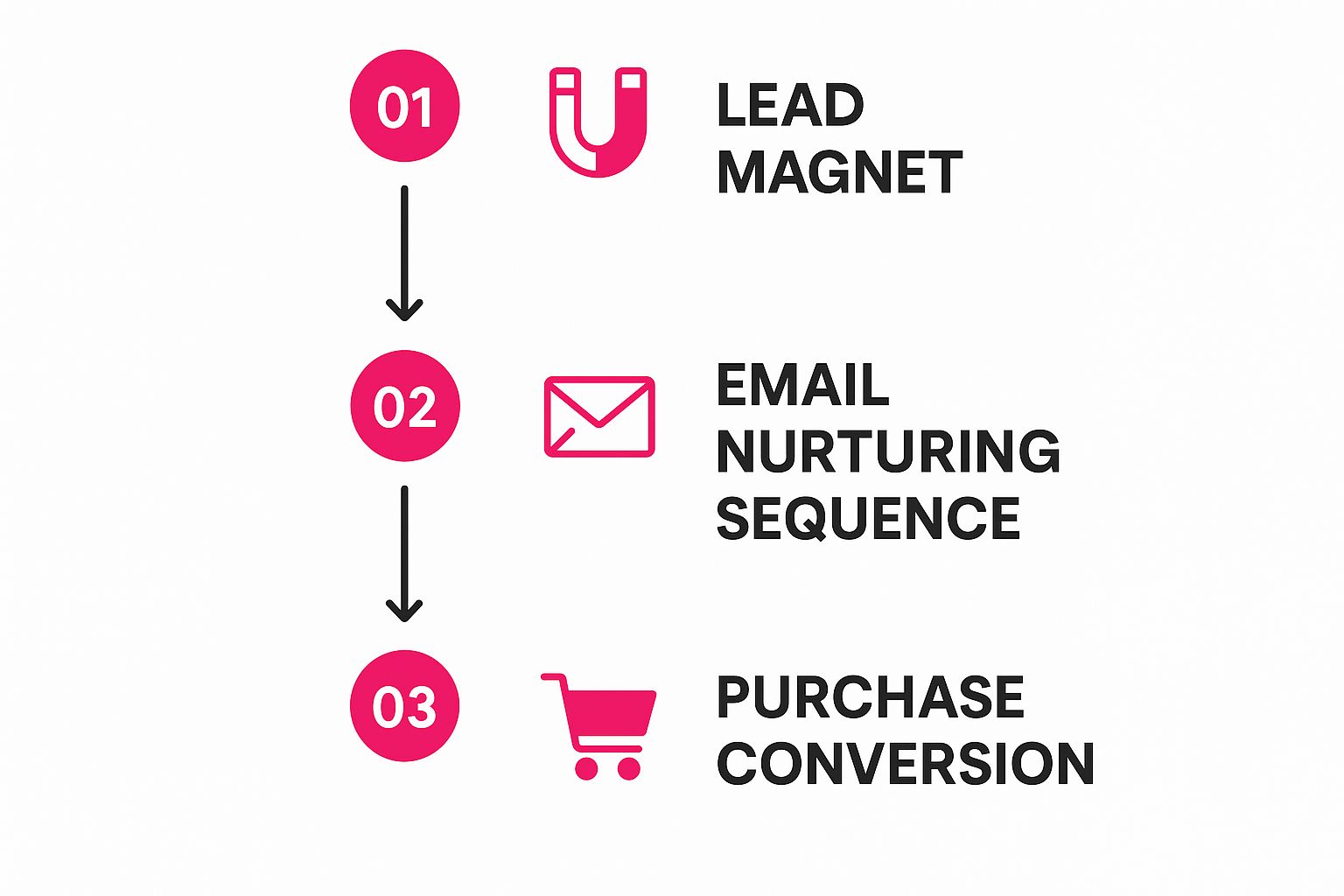
This process flow highlights how each stage logically follows the last, guiding a prospect from initial interest to a final conversion decision.
Actionable Takeaways
- Create an Irresistible Lead Magnet: Your free offer must solve a specific, urgent problem for your target audience. A generic newsletter sign-up is not a strong magnet.
- Segment Your Nurturing: If possible, segment leads based on their behaviour or the specific lead magnet they downloaded. This allows for more personalised and effective email content.
- Implement Lead Scoring: Assign points to leads based on actions like opening emails, clicking links, or visiting your pricing page. This helps your sales team identify and prioritise the most engaged, sales-ready prospects.
3. The Value-First Approach: Content Marketing Funnel Example
The content marketing funnel is a strategic model that uses valuable, educational, and relevant content to attract, engage, and convert an audience. Rather than pushing a direct sale, this approach focuses on building trust and establishing authority by solving problems for prospects at each stage of their buying journey. It's one of the most sustainable marketing funnel examples because it creates brand equity and a loyal audience over time.
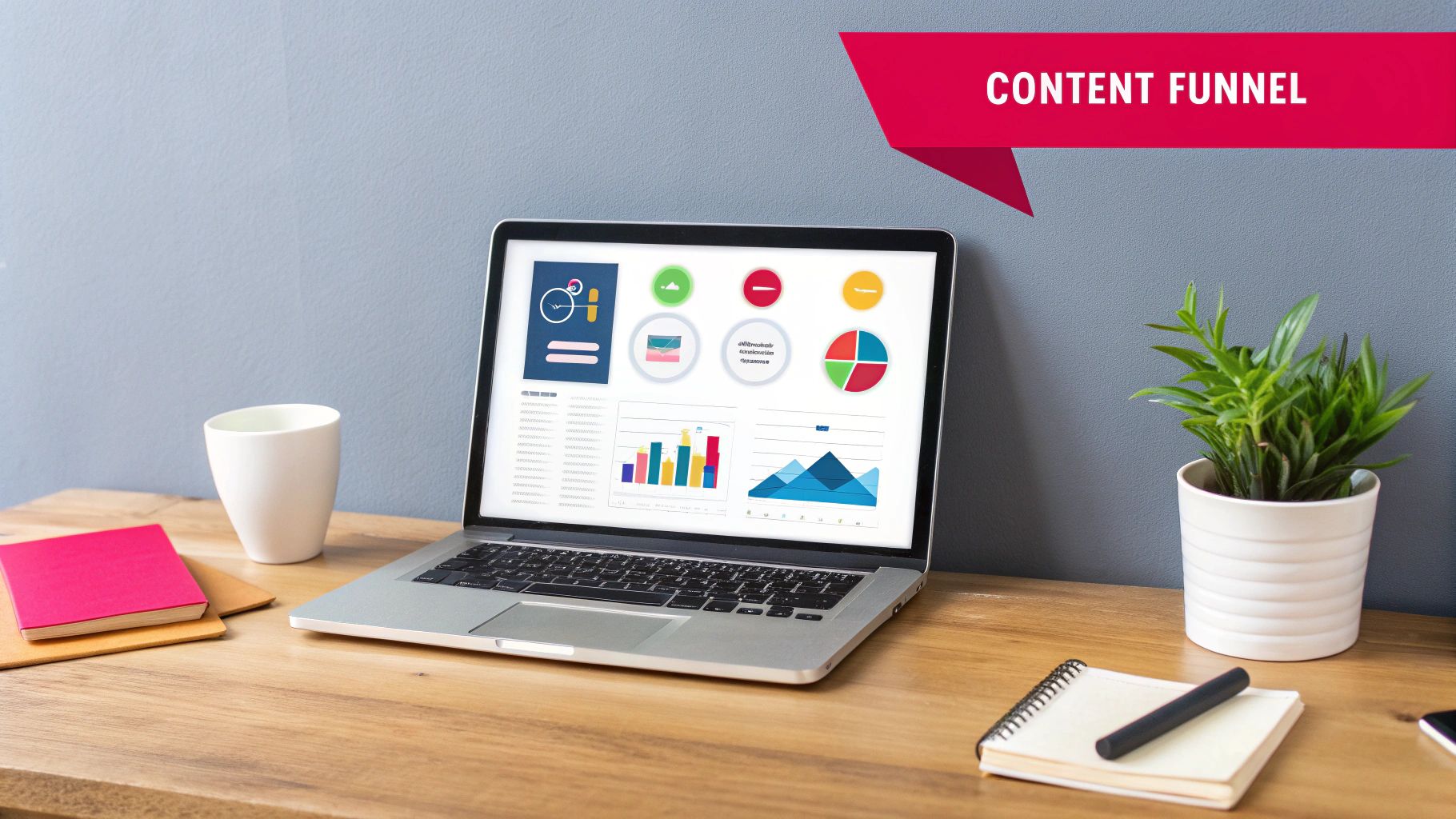
The funnel is typically organised into three main stages:
- Top of the Funnel (ToFu): Attracting a broad audience with high-level, problem-aware content like blog posts, social media updates, and infographics.
- Middle of the Funnel (MoFu): Engaging prospects who are actively seeking solutions with more in-depth content like ebooks, whitepapers, webinars, and case studies. This stage focuses on lead capture.
- Bottom of the Funnel (BoFu): Converting highly qualified leads into customers with product-focused content like demos, free trials, consultations, and detailed feature comparisons.
Strategic Breakdown: Content Marketing in Action
Let’s examine how Buffer, a social media management tool, masterfully uses a content marketing funnel.
Stage 1: Top of Funnel (Awareness)
Buffer attracts a massive audience of marketers and business owners through its widely respected blog. They publish high-quality articles on topics like "The Best Time to Post on Instagram" or "Social Media Algorithm Changes." This content doesn't aggressively sell their tool; it provides immense value and answers common questions, ranking high on search engines and establishing Buffer as a go-to resource.
Stage 2: Middle of Funnel (Consideration)
Within their blog posts, Buffer strategically places calls-to-action (CTAs) for more in-depth resources, such as an "Annual State of Social" report or a webinar on social media strategy. To access these, users must provide their email address, converting them from anonymous readers into leads. Once created, effective content distribution strategies are vital to ensure this mid-funnel content reaches the right segments of their audience.
Stage 3: Bottom of Funnel (Decision)
Leads are nurtured through email sequences that continue to offer value but also begin introducing Buffer as the ideal solution to the challenges discussed in their content. They will receive emails highlighting specific features, customer success stories, and eventually, a clear and compelling CTA to "Start a Free Trial" of the Buffer platform, directly linking the educational content to their paid product.
Actionable Takeaways
- Map Content to Journey: Don't just create content; map each piece to a specific stage (ToFu, MoFu, BoFu) and a user's intent. A beginner's guide serves a different purpose than a detailed case study.
- Implement Content Upgrades: Increase lead generation from your blog posts by offering a specific, high-value bonus (like a checklist or template) in exchange for an email. This is more effective than a generic newsletter sign-up.
- Build Topic Clusters: Organise your content around a central "pillar" page for a broad topic, with multiple "cluster" articles linking back to it. This boosts SEO authority and guides users through your funnel. Learn more about how to build a powerful content marketing strategy to implement these tactics effectively.
4. The Expert's Stage: Webinar Marketing Funnel
The webinar marketing funnel is a powerful model that leverages live or pre-recorded online presentations to educate, build authority, and convert an audience in a single, focused event. It excels at guiding prospects from awareness to decision by delivering significant value upfront before making a sales offer. Popularised by experts like Amy Porterfield and Russell Brunson, this approach is one of the most effective marketing funnel examples for selling high-ticket products, courses, or services.
The funnel operates on a principle of reciprocity and expertise:
- Registration: Attracting sign-ups for the webinar through various promotional channels like social media ads, email lists, or content marketing.
- Nurturing: Building anticipation and ensuring attendance through a sequence of reminder emails that often share pre-webinar value.
- Presentation: Delivering a high-value educational session (typically 80-90% content) that solves a specific problem for the audience.
- Pitch & Conversion: Transitioning smoothly from the educational content to a compelling offer (the remaining 10-20%), often with a sense of urgency, to drive immediate action.
Strategic Breakdown: Webinar Funnel in Action
Consider a financial advisor aiming to generate qualified leads for their retirement planning services.
Stage 1: Registration (Attention & Interest)
The advisor runs targeted Facebook and Instagram ads with a compelling hook: "Discover 3 Strategies to Secure Your Retirement in the UAE – Even if You're Starting Late." The ads direct users to a simple landing page that clearly states the webinar's promised outcome, date, and time, requiring only a name and email to register.
Stage 2: Nurturing (Desire)
Once registered, attendees receive a series of three automated emails. The first confirms their spot and adds the event to their calendar. The second, sent two days before, shares a "Retirement Readiness Checklist" PDF to get them thinking about the topic. The final email is a simple reminder an hour before the webinar starts.
Stage 3: Presentation (Building Trust)
During the live webinar, the advisor spends 45 minutes teaching valuable, actionable strategies about local investment options and savings plans. They use interactive polls like, "What is your biggest retirement concern?" to keep the audience engaged and showcase their expertise by answering questions live.
Stage 4: Pitch & Conversion (Action)
In the final 15 minutes, the advisor transitions to the offer: "If you found this helpful and want a personalised plan, I'm offering a complimentary 1-on-1 Retirement Strategy Session to the first 10 people who book." A link to their calendar is shared, and a special bonus (e.g., a detailed guide to expat investing) is offered to those who book during the webinar, creating urgency. Post-webinar emails are sent to attendees with the recording and offer, and a different set of emails is sent to no-shows to encourage them to watch the replay.
Actionable Takeaways
- Follow the 80/20 Value Rule: Dedicate the vast majority of your presentation to pure value and education. An aggressive, lengthy sales pitch will alienate the audience you just worked to build trust with.
- Create Urgency Ethically: Your offer should feel special for attendees. Use time-sensitive bonuses or limited-slot offers to encourage immediate action rather than procrastination.
- Segment Your Follow-up: Don't treat attendees and no-shows the same. Send attendees a "thank you" with the offer. Send no-shows a "you missed out" email with the recording and a final chance to access the offer.
5. The Community-Powered Engine: Social Media Marketing Funnel
The social media marketing funnel leverages platforms like Instagram, LinkedIn, and TikTok to guide users from initial awareness to loyal advocacy. Unlike linear funnels, this model is dynamic, using organic content, community engagement, and paid ads to build relationships. It excels at turning passive followers into active customers by fostering a sense of community and trust directly where users spend their time. This approach is one of the most powerful marketing funnel examples for brands seeking to build a strong, interactive presence.
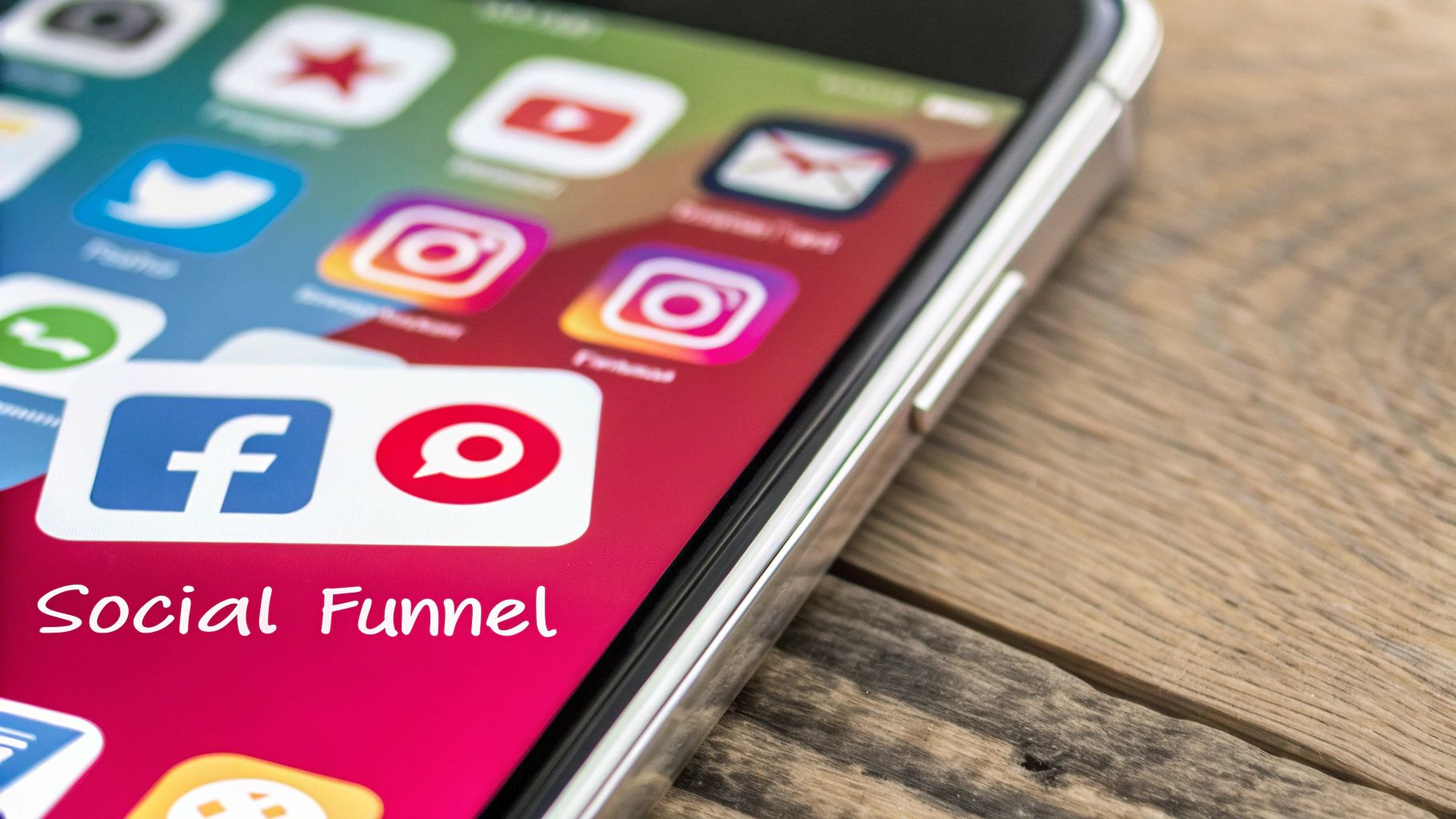
This funnel typically involves these stages, often fluidly:
- Awareness: Reaching new audiences through shareable content like viral videos, informative infographics, or paid campaigns targeting specific interests.
- Engagement: Fostering a community by responding to comments, running polls, hosting live Q&As, and encouraging user-generated content (UGC).
- Conversion: Driving action through platform-native tools like Instagram Shopping, lead generation forms, or direct messages that guide users to a landing page.
- Advocacy: Delighting customers so they become brand ambassadors, sharing their positive experiences and creating a powerful loop of social proof that fuels the top of the funnel.
Strategic Breakdown: Social Media Funnel in Action
Let’s analyse how a direct-to-consumer (DTC) beauty brand like Glossier used Instagram to build an empire.
Stage 1: Awareness
Glossier initially built hype through its founder's popular blog, "Into The Gloss." On Instagram, they focused on a distinct, minimalist aesthetic. Their content wasn't just product shots; it was a lifestyle. They used targeted ads showing authentic, diverse models to reach beauty enthusiasts who were tired of overly polished advertising.
Stage 2: Engagement
The brand mastered community-building by actively reposting user-generated content. When a follower tagged Glossier in a post, they had a chance to be featured on the official page. This created a powerful incentive for engagement and flooded the platform with authentic social proof. They also used Instagram Stories to ask questions, run polls about product development, and make their followers feel like insiders.
Stage 3: Conversion
Glossier seamlessly integrated e-commerce into its feed. Using Instagram's shopping tags, users could tap on a product in a post and immediately see its price and a link to purchase. This frictionless path from discovery to purchase was crucial. For new product launches, they drove traffic to "link in bio" landing pages, creating a sense of urgency and exclusivity.
Stage 4: Advocacy
The iconic pink bubble-wrap pouches and sticker sheets that came with every order were highly "Instagrammable." Customers were excited to unbox their packages and share photos online, creating an endless cycle of organic marketing. This user-led advocacy became Glossier's most effective tool for attracting new customers.
Actionable Takeaways
- Platform-Specific Content: Tailor your content for each platform's unique culture. Humour works well on Twitter, professional insights thrive on LinkedIn, and visual aesthetics dominate Instagram.
- Prioritise Community Over Conversion: Focus first on providing value and building genuine relationships through engagement. Sales will follow from the trust you build.
- Leverage User-Generated Content: Actively encourage and showcase content from your customers. It's a free, authentic marketing asset that builds immense social proof and community loyalty.
6. The Nurturing Engine: Email Marketing Funnel Example
The email marketing funnel is a powerful, direct-to-inbox strategy designed to systematically nurture leads into loyal customers. It excels at building relationships over time by delivering personalised, valuable content directly to an audience that has opted in. This funnel focuses on capturing subscribers, segmenting them based on behaviour, and guiding them through awareness and consideration with automated sequences, making it one of the most effective marketing funnel examples for long-term value.
The process typically involves these key stages:
- Capture: Attracting subscribers through a valuable offer, known as a lead magnet, like an ebook, a webinar, or a discount code.
- Nurture: Engaging subscribers with a pre-planned sequence of emails that builds trust, educates them, and introduces the problem your product solves.
- Convert: Presenting a targeted offer to a warmed-up audience, prompting a purchase or another desired action.
- Retain & Advocate: Continuing to provide value post-purchase to encourage repeat business, loyalty, and referrals.
Strategic Breakdown: Email Funnel in Action
Let’s examine how Grammarly, the AI-powered writing assistant, uses an email funnel to convert free users into premium subscribers.
Stage 1: Capture (Top of Funnel)
Grammarly offers a robust and genuinely useful free browser extension. The "lead magnet" is the tool itself. To use it, a user must sign up with their email, instantly adding them to the top of the funnel.
Stage 2: Nurture (Middle of Funnel)
Once subscribed, users begin receiving weekly "Grammarly Insights" emails. These are not sales pitches. Instead, they provide personalised statistics like, "You were more productive than 88% of Grammarly users," and offer tips based on their common mistakes. This builds a habit and consistently demonstrates the tool's value.
Stage 3: Convert (Bottom of Funnel)
Within these value-packed nurture emails, Grammarly strategically places calls-to-action for its Premium service. The messaging highlights features the user isn't accessing, such as "Unlock advanced suggestions for clarity and tone." By showing the user what more they could achieve, Grammarly creates a compelling desire to upgrade. They often include a limited-time discount to create urgency.
Stage 4: Retain & Advocate (Post-Funnel)
For Premium users, the emails continue, offering advanced tips and new feature announcements. This reinforces the value of their subscription, reduces churn, and turns happy customers into advocates who recommend the tool to others. You can explore how such automated sequences are built in this guide to email marketing automation strategy.
Actionable Takeaways
- Lead with Value: Your initial offer or lead magnet must be compelling enough for someone to exchange their email address for it. Don’t hold back your best introductory content.
- Segment Your Audience: Not everyone is at the same stage. Segment your list based on engagement (e.g., opened last 3 emails) or behaviour (e.g., clicked a specific link) to send highly relevant messages.
- Automate the Journey: Use behavioural triggers to automate your email sequences. If a user visits a pricing page but doesn't buy, trigger a sequence that addresses common objections or offers a special discount.
7. The Video Marketing Funnel Example
The Video Marketing Funnel leverages the power of visual storytelling to guide prospects through the customer journey. Capitalising on video's high engagement rates, this model uses different types of video content tailored to each stage of the funnel, from broad brand awareness to specific conversion-focused tutorials. It is one of the most dynamic marketing funnel examples, transforming passive viewers into active customers.
This funnel operates across multiple stages, often mirroring the AIDA model:
- Awareness (Top of Funnel): Capturing wide-scale attention with entertaining, shareable, or educational content.
- Consideration (Middle of Funnel): Nurturing interest by demonstrating product value and solving specific problems.
- Conversion (Bottom of Funnel): Driving action with testimonials, demos, and clear calls-to-action that build trust and urgency.
Strategic Breakdown: The Video Funnel in Action
Let's examine how a tech accessory brand, like a maker of high-end camera gear, could implement a video marketing funnel.
Stage 1: Awareness
The brand partners with a popular travel vlogger on YouTube for a sponsored video. The vlogger uses the brand’s new gimbal in a cinematic travel short, showcasing its smooth stabilisation capabilities in a real-world, highly engaging context. This introduces the product to a large, relevant audience without a hard sell.
Stage 2: Consideration
Viewers who showed interest, perhaps by watching a certain percentage of the YouTube video, are retargeted on Instagram and Facebook. They are shown short, problem-focused videos titled, "Say Goodbye to Shaky Footage Forever." These clips compare footage with and without the gimbal, directly addressing a key pain point for aspiring creators. A link directs them to a product page.
Stage 3: Conversion
On the product page, visitors find a detailed video demo hosted by a professional filmmaker. This video breaks down the technical features, setup process, and advanced capabilities. Just below the video, a carousel of short video testimonials from happy customers plays on a loop, building social proof. A clear CTA button, "Add to Cart for Smoother Shots," prompts the final purchase.
Actionable Takeaways
- Hook Within Three Seconds: In the awareness stage, your video's opening is critical. Use a strong visual hook, a provocative question, or surprising movement to stop the scroll.
- Optimise for Each Platform: A 10-minute YouTube deep dive won't work as a 30-second Instagram Reel. Create platform-specific versions with optimal dimensions (vertical for mobile, horizontal for YouTube) and include captions for silent viewing.
- Use Video Retargeting: Segment viewers based on their engagement (e.g., watched 75% of a video) and serve them the next-stage video. This ensures you are nurturing the most interested leads.
8. Retargeting/Remarketing Funnel
The Retargeting Funnel is a powerful, conversion-focused strategy designed to re-engage users who have already shown interest in your brand but left without completing a key action. It operates on the principle that it's easier to convert a warm lead than a cold one. By using tracking pixels (like the Meta Pixel or Google Ads tag), this funnel identifies past website visitors and serves them specific, relevant ads across other platforms, guiding them back towards conversion.
This funnel is crucial because most first-time visitors are not ready to buy. A retargeting strategy ensures your brand stays top-of-mind, systematically addressing hesitations and reminding them of the value you offer. The funnel typically segments users based on their behaviour:
- Awareness: The user has visited your site but hasn't taken a specific action.
- Consideration: The user has viewed specific products, added items to a cart, or watched a significant portion of a video.
- Conversion: The user is served increasingly compelling offers to overcome final barriers and make a purchase or sign up.
Strategic Breakdown: Retargeting in Action
Imagine an e-commerce store that sells high-end running shoes. A potential customer visits, browses the "Trail Running Shoes" category, and views a specific pair but leaves the site without purchasing.
Stage 1: Awareness & Initial Re-engagement (Days 1-3)
The store’s retargeting pixel fires. Within 24 hours, the user sees a dynamic product ad on Facebook and Instagram featuring the exact pair of trail running shoes they viewed. The ad copy is simple and reinforces value: "Still thinking it over? Discover why the [Shoe Name] is a trail runner's favourite."
Stage 2: Consideration & Social Proof (Days 4-7)
If the user still hasn't converted, the ad creative changes. They are now shown a carousel ad or short video featuring a customer testimonial about those specific shoes. The copy might read, "See how the [Shoe Name] helped Sarah conquer her first ultramarathon." This shifts the focus from the product to a relatable success story, building trust and desire.
Stage 3: Conversion & Urgency (Days 8-14)
For the final push, the user is served an ad with a clear incentive. The headline reads, "Ready to Hit the Trails? Get 10% Off Your First Order + Free Shipping." This limited-time offer creates a sense of urgency and provides a compelling reason to overcome any final price hesitation and complete the purchase. Once they buy, they are automatically excluded from this ad campaign.
Actionable Takeaways
- Segment Audiences by Intent: Don't treat all visitors the same. Create separate retargeting audiences for homepage visitors, product page viewers, and cart abandoners. Tailor your ad messaging to match how far down the funnel they are.
- Implement Frequency Caps: To avoid annoying potential customers and causing ad fatigue, set a frequency cap. This limits the number of times a single user will see your ad within a specific period, keeping the interaction positive.
- Develop Progressive Messaging: Your ad sequence should tell a story. Start with a simple reminder, then introduce social proof or benefits, and finally, present a direct offer. This gradual persuasion is more effective than repeatedly showing the same ad.
Marketing Funnel Types Comparison Overview
| Funnel Type | Implementation Complexity 🔄 | Resource Requirements ⚡ | Expected Outcomes 📊 | Ideal Use Cases 💡 | Key Advantages ⭐ |
|---|---|---|---|---|---|
| AIDA Marketing Funnel | Low 🔄 (Simple, linear stages) | Low ⚡ (Flexible content needs per stage) | Moderate 📊 (Guides customers through 4 clear stages) | E-commerce launches, B2C ads, content marketing | Easy to implement, universal, cost-effective |
| Sales Funnel (Lead Magnet) | Medium 🔄 (Multi-touch, automated workflows) | Medium-High ⚡ (Content creation, automation systems) | High 📊 (Systematic lead conversion and nurturing) | Lead generation, software sales, real estate | Scalable, relationship-building, clear ROI tracking |
| Content Marketing Funnel | Medium-High 🔄 (Consistent, diverse content) | High ⚡ (Ongoing content creation, SEO optimization) | Long-term 📊 (Brand authority, organic traffic growth) | Educational content, SaaS, brand building | Builds trust, lowers acquisition cost over time |
| Webinar Marketing Funnel | Medium-High 🔄 (Live/automated setup, interaction) | Medium-High ⚡ (Preparation, tech setup, live events) | High 📊 (High conversion rates, personal connection) | Course launches, demos, financial services | Real-time engagement, high conversion |
| Social Media Marketing Funnel | Medium 🔄 (Platform-specific strategies) | Medium ⚡ (Content creation, community management) | Variable 📊 (Viral reach, direct engagement) | Brand awareness, community building, direct sales | Large audience access, viral potential, targeted ads |
| Email Marketing Funnel | Medium 🔄 (Automation, segmentation complexity) | Medium ⚡ (Email sequences, list maintenance) | High 📊 (High ROI, personalized nurturing) | List-building, e-commerce, B2C nurturing | High ROI, direct channel, detailed analytics |
| Video Marketing Funnel | High 🔄 (Production, platform optimization) | High ⚡ (Production costs, technical needs) | High 📊 (Strong engagement, storytelling) | Product demos, brand storytelling, tutorials | High engagement, emotional connection, SEO benefits |
| Retargeting/Remarketing Funnel | Medium 🔄 (Pixel setup, segmentation, cross-platform) | Medium ⚡ (Ad creation, management platforms) | High 📊 (Improved conversion, efficient ad spend) | E-commerce, subscription renewals, abandoned carts | Targets warm audiences, cost-effective, measurable |
Building Your Own High-Conversion Funnel
Throughout this deep dive into diverse marketing funnel examples, a central theme has emerged: there is no universal key that unlocks every market. The power lies not in finding a single, perfect funnel template but in the strategic fusion of different models. We have analysed everything from the foundational AIDA model to highly specialised webinar, social media, and retargeting funnels. Each example showcases a unique path, yet they are all built on the same bedrock principles.
The common thread weaving through every successful case study is an unwavering, almost obsessive focus on the customer journey. High-conversion funnels are not constructed with business needs at their centre; they are meticulously architected around the customer's evolving questions, pain points, and motivations at each sequential stage. This customer-centric approach is the non-negotiable starting point for building a funnel that doesn't just guide, but truly serves your audience.
Distilling the Core Principles for Your Business
From the content-driven lead generation of a B2B SaaS company to the visually-led impulse purchases of an e-commerce brand, the strategic DNA remains consistent. To begin building your own, you must move beyond theory and apply these core principles directly to your unique business context.
- Map the Authentic Journey: Start by sketching out your ideal customer's path. Forget industry jargon and think like them. What is the very first problem they are trying to solve that could lead them to you? What questions do they google? What do they need to believe before they consider a solution like yours?
- Deliver Stage-Specific Value: Your top-of-funnel (TOFU) content, like a blog post or a viral video, should educate and entertain, not sell. Your middle-of-funnel (MOFU) assets, such as a detailed case study or a webinar, should help them evaluate options. Finally, your bottom-of-funnel (BOFU) offers, like a free trial or a consultation, should make the decision to buy as easy and risk-free as possible.
- Choose Channels with Intent: Don’t stretch yourself thin across every platform. Where does your audience actually spend their time and seek information? A B2B audience might be more receptive to LinkedIn and email, while a fashion brand will find its home on Instagram and TikTok. Match the channel to the funnel stage and the audience’s natural behaviour.
The Unspoken Rule: Relentless Optimisation
Building the funnel is merely the first step. The true masters of marketing understand that a funnel is a living system, not a static blueprint. It requires constant attention, measurement, and refinement. Every element, from your ad creative to your landing page headline and your email subject line, is a variable that can be tested and improved.
To ensure your funnels are not just converting but also cost-effective, it's vital to understand key metrics. Mastering these numbers allows you to make data-driven decisions that increase profitability. For a deeper understanding of this crucial aspect, learning how to lower your Cost Per Acquisition (CPA) is an essential next step in your optimisation journey. By continuously analysing performance data, you can identify leaks, seal gaps, and double down on what truly works, transforming a good funnel into a great one.
These marketing funnel examples prove that a well-constructed funnel is more than a sales process; it's a powerful engine for sustainable growth. It provides a predictable system for generating leads and customers, allowing you to scale your business with confidence. By applying the strategic insights and actionable takeaways we've covered, you are now equipped to build a robust, high-conversion machine tailored perfectly to your brand.
Feeling inspired by these marketing funnel examples but need an expert partner to help you design, build, and optimise your own? Grassroots Creative Agency specialises in crafting bespoke, data-driven marketing funnels that convert prospects into loyal customers. Visit Grassroots Creative Agency to see how we can build the growth engine your business deserves.

